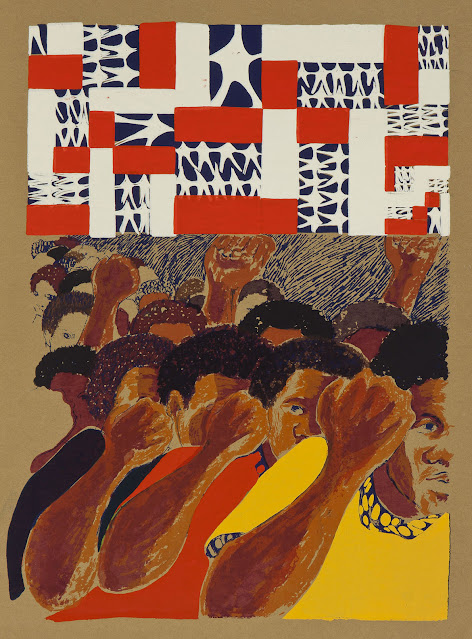In 1968, printmaker Barbara Jones-Hogu was a founding member of the Chicago group, African Commune of Bad Relevant Artists (AfriCOBRA). The artists of AfriCOBRA made visual, the central ideas of the Black Power movement—self-determination, unity, and black pride. They agreed to embrace a style that emphasized strong bold colors, flat shape, rhythm, and text to highlight the heroic and beautiful qualities of black lives in America.
https://americanart.si.edu/education/oh-freedom/barbara-jones-hogu
The prints created by Barbara Jones-Hogu, stand as brilliant works of art and at the same time reveal a glimpse into America’s history of embedded racism and the importance of protest.
Land Where My Father Died
Color screenprint on gold-colored Japanese-style laid paper. 1968,
“…I feel that racism and fascism played a great deal in my father being successful or not successful in his life, so some of these prints’ ideas and content deal with the fact that we and he were not really free to do whatever we and he really wanted to do and could do due to radical oppression and suppression…”
https://never-the-same.org/interviews/barbara-jones-hogu/
Nation Time
Color screenprint on gold-colored paper, 1970,
“…In Nation Time, a dominant figure leads a black ensemble to rise up against the American flag background. Closer looking reveals that the American flag’s stars are Ku Klux Klan members. In this way, the composition acknowledges how racism is deeply embedded in America, while also inspiring hope of overcoming that truth…”
Be Your Brother's Keeper
Color screenprint, 1971
“…The guns and the lights on them and various actions against and between the military and the protesters caused me to think that we should be our brothers’ keeper…”
https://never-the-same.org/interviews/barbara-jones-hogu/
Unite (AfriCOBRA)
Color screenprint on ivory wove paper 1971
YouTube Version:
For further information on Barbara Jones-Hogu and AfriCOBRA:
https://never-the-same.org/interviews/barbara-jones-hogu/
Joel Elgin Art Sites:
https://www.joelelginathraighprintstudio.com/
Instagram:
https://www.instagram.com/joel.elgin.athraighprintstudio/
Twitter:









